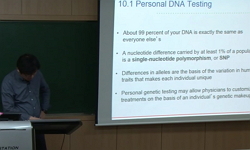연구 배경 및 목적: 비바이러스 벡터를 이용한 줄기 세포의 유전적 조작은 낮은 형질 감염 효율로 인해 여전히 제한적이다. 이번 연구에서 DNA 결합 세포투과펩타이드(CPP)가 지방조직유래 중...
http://chineseinput.net/에서 pinyin(병음)방식으로 중국어를 변환할 수 있습니다.
변환된 중국어를 복사하여 사용하시면 됩니다.
- 中文 을 입력하시려면 zhongwen을 입력하시고 space를누르시면됩니다.
- 北京 을 입력하시려면 beijing을 입력하시고 space를 누르시면 됩니다.
DNA-binding Cell-penetrating Peptide-based TRAIL Over-expression in Adipose Tissue-derived Mesenchymal Stem Cells Inhibits Glioma U251MG Growth = DNA결합 세포투과펩타이드 기반 TRAIL 과발현 지방조직유래 중간엽 줄기세포의 신경교종 U251MG 성장 억제
한글로보기https://www.riss.kr/link?id=T15906422
- 저자
-
발행사항
서울 : 연세대학교 일반대학원, 2021
-
학위논문사항
학위논문(박사) -- 연세대학교 일반대학원 , 의학과 , 2021. 8
-
발행연도
2021
-
작성언어
영어
- 주제어
-
DDC
610
-
발행국(도시)
서울
-
형태사항
vi, 22p. ; 26 cm
-
일반주기명
지도교수: 황금
-
UCI식별코드
I804:11046-000000537643
- 소장기관
-
0
상세조회 -
0
다운로드
부가정보
국문 초록 (Abstract)
연구 배경 및 목적: 비바이러스 벡터를 이용한 줄기 세포의 유전적 조작은 낮은 형질 감염 효율로 인해 여전히 제한적이다. 이번 연구에서 DNA 결합 세포투과펩타이드(CPP)가 지방조직유래 중간엽 줄기세포(ASC)에서 비바이러스 벡터의 형질감염 효율을 향상시킬 수 있는지, 그리고 세포투과펩타이드(CPP)를 통해 TRAIL을 과발현하는 지방조직유래 중간엽 줄기세포(ASC)가 세포 실험 및 동물 실험에서의 신경교종 U251MG의 성장을 억제할 수 있는지 연구하였다. 재료 및 방법: 지방조직유래 중간엽 줄기세포(ASC)는 CPP, PCMV3-TRAIL 및 지질기반 형질감염시약(X-tremeGENE)을 사용하여 TRAIL을 과발현하도록 유전적으로 조작하였다. 결과: 지방조직유래 중간엽 줄기세포(ASC)의 형질감염 효율은 세포투과펩타이드(CPP)를 사용하여 약 7% 증가하였다. 지방조직유래 중간엽 줄기세포(ASC)의 53.9%가 형질감염 되었고 지방조직유래 중간엽 줄기세포(ASC)에서 TRAIL 발현이 지질 기반 형질감염 물질(X-tremeGENE) 단독 사용에 비해 최대 3배 증가하였다. 세포투과펩타이드(CPP)를 사용하여 TRAIL을 과발현하는 지방조직유래 중간엽 줄기세포(ASC)는 세포 실험 및 U251MG 이종 이식 모델 모두에서 신경교종 U251MG의 성장을 억제하였다. 결론: 세포투과펩타이드(CPP)는 지방조직유래 중간엽 줄기세포(ASC)를 유전적으로 조작하여 종양을 치료하기 위한 증폭자로 사용할 수 있을 것으로 사료된다.
다국어 초록 (Multilingual Abstract)
Background/Aim: Genetic manipulation of stem cells using non-viral vectors is still limited due to low transfection efficiency. We investigated whether the DNA-binding cell-permeation peptides (CPP) can enhance the transfection efficiency of non-viral...
Background/Aim: Genetic manipulation of stem cells using non-viral vectors is still limited due to low transfection efficiency. We investigated whether the DNA-binding cell-permeation peptides (CPP) can enhance the transfection efficiency of non-viral vectors in adipose tissue-derived mesenchymal stem cells (ASCs) and whether ASCs over-expressing TRAIL through CPP can inhibit the growth of glioma U251MG cells in vitro and in vivo. Materials and Methods: ASCs were genetically engineered to over-express TRAIL by using CPP, pCMV3-TRAIL and lipid-based transfection reagents (X-tremeGENE). Results: The transfection efficiency of ASCs increased by approximately 7% using CPP; 53.9% of ASCs were transfected and TRAIL expression in ASCs increased by approximately 3 times compared to X-tremeGENE alone. ASCs over-expressing TRAIL using CPP inhibited growth of glioma U251MG cells both in vitro and in the U251MG xenograft model. Conclusion: CPP can be used as an enhancer for genetically manipulating ASCs and tumor treatment.
목차 (Table of Contents)
- I. INTRODUCTION
- 1.1 Research background and aim
- II. MATERIAL AND METHODS
- 2.1. Cell culture
- I. INTRODUCTION
- 1.1 Research background and aim
- II. MATERIAL AND METHODS
- 2.1. Cell culture
- 2.2. Synthesis of CPP and analysis of its binding to the supercoiled plasmid
- 2.3. ASC transfection
- 2.4. MTT assay
- 2.5. Immunoblotting
- 2.6. Apoptosis assay
- 2.7. Animal studies
- 2.8. Statistical analysis
- III. RESULTS
- 3.1. Binding affinity of CPP for pCMV3-GFP
- 3.2. Enhancement of the transfection efficiency of ASCs with plasmid vectors by DNA-binding CPP
- 3.3. Cytotoxicity of U251MG by ASC-TRAIL
- 3.4. Anti-tumor effects of ASC-TRAIL in xenograft animal model
- IV. DISCUSSION
- V. REFERENCES
- VI. ABSTRACT OF KOREAN













